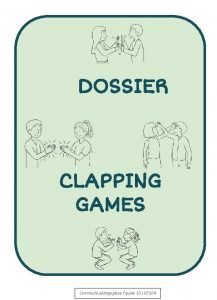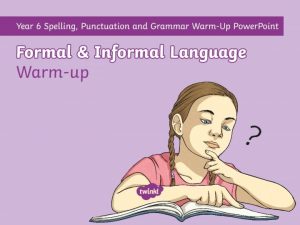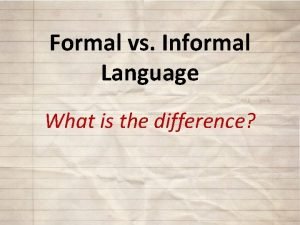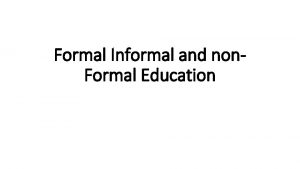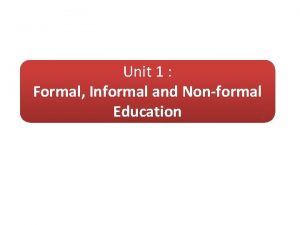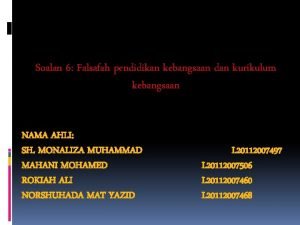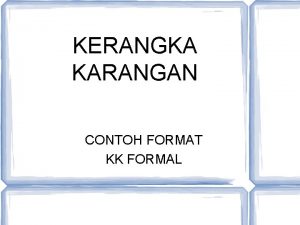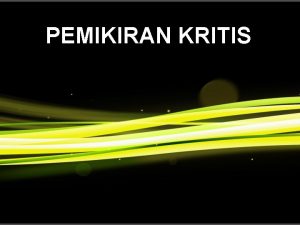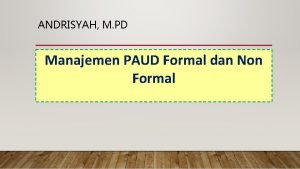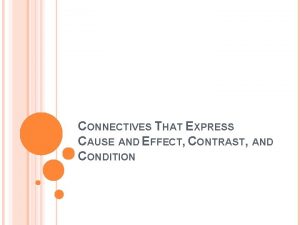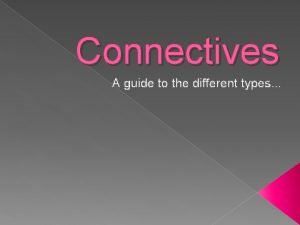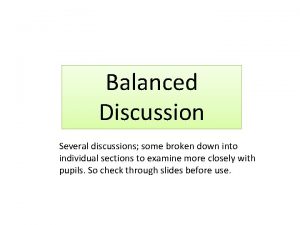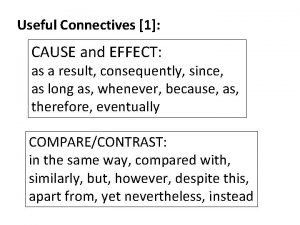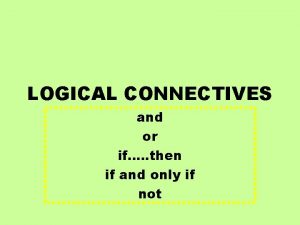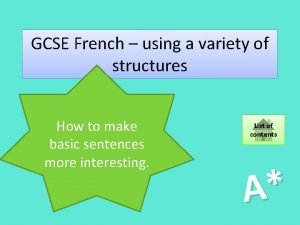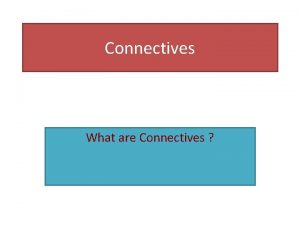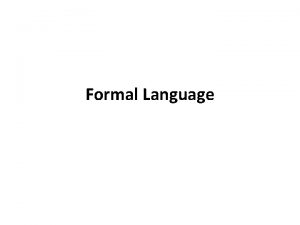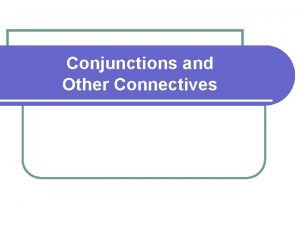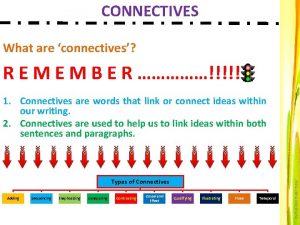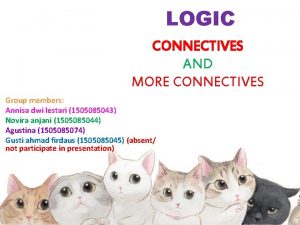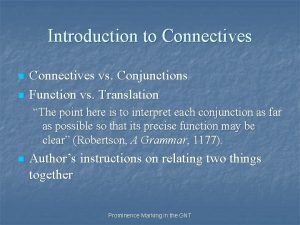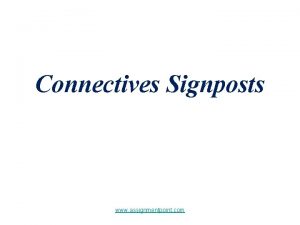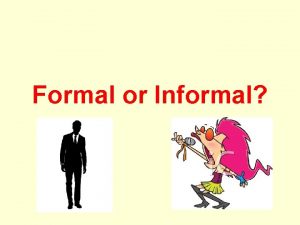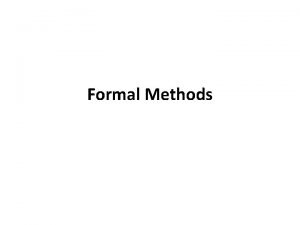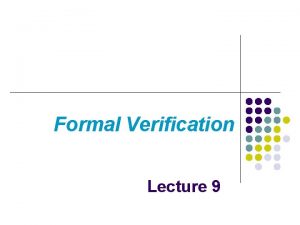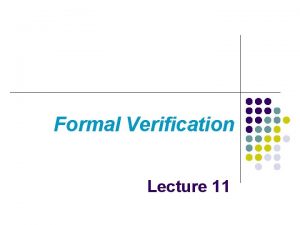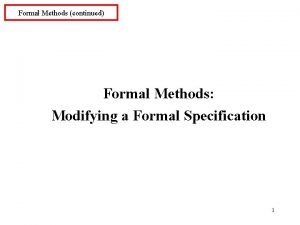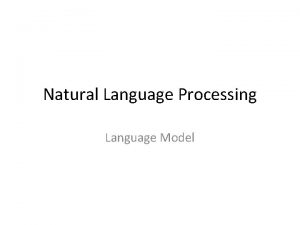Going Formal Meet the Connectives The Language of


















![Identifying WFFs & Main Connectives 6 D [ ( P Q) (T R) ] Identifying WFFs & Main Connectives 6 D [ ( P Q) (T R) ]](https://slidetodoc.com/presentation_image_h/038f813ee64a49d60c5509b942d6b9b9/image-19.jpg)









- Slides: 28

Going Formal Meet the Connectives

The Language of Propositional Logic • Syntax (grammar, internal structure of the language) – Vocabulary: grammatical categories – Identifying Well-Formed Formulae (“WFFs”) • Semantics (pertaining to meaning and truth value) – Translation – Truth functions – Truth tables for the connectives

The Vocabulary of Propositional Logic • Sentence Letters: A, B, … Z • Connectives (“Sentence-Forming Operators”) ~ negation “not, ” “it is not the case that” ⋅ conjunction “and” ∨ disjunction “or” (inclusive) ⊃ conditional “if – then, ” “implies” ≣ biconditional “if and only if, ” “iff” • “Parentheses”: (, ), [, ], {, and }

Sentence Letters • Translate “atomic” sentences • Atomic sentences have no proper parts that are themselves sentences • Examples: – It is raining R – It is cold C

Sentential Connectives • Connect to sentences to make new sentences • Negation attaches to one sentence – It is not raining ∼R • Conjunction, disjunction, conditional and biconditional attach two sentences together – It is raining and it is cold – If it rains then it pours R∙C R⊃P

Parentheses, brackets & braces • I’ll go to Amsterdam and Brussels or Calais • This is ambiguous and we can’t tolerate ambiguity! Brussels Amsterdam AND OR Calais Amsterdam OR Calais AND Brussels

Parentheses, brackets & braces • Grouping devices avoid ambiguity (for “unique readability”): – I’ll go to Amsterdam, and then to either Brussels or Calais A ∙ (B ∨ C) Amsterdam Brussels AND OR Calais – I’ll either go to Amsterdam and Brussels, or else to Calais (A ∙ B) ∨ C Amsterdam OR Calais AND Brussels

Variables: p, q, … • Sometimes we want to talk about all sentences of a given form, e. g. A (B C) F (M X) (K M) [(N O) P] • So we use variables as place-holders • Each of the above sentences is of the form: p (q r)

Plugging into variables Modus Ponens p q Substitution Instance of Modus Ponens ((A B) C) (D (E F)) • Variables are like expandable boxes • To do proofs in logic you have to see how sentences plug into those boxes.

Plugging into variables Modus Ponens p q Substitution Instance of Modus Ponens ((A B) C) (D (E F)) • Variables are like expandable boxes • To do proofs in logic you have to see how sentences plug into those boxes.

The Grammar of Propositional Logic • Constructing WFFs (Well-Formed Formulae) • Identifying WFFs • Identifying main connectives

Rules for WFFs 1. A sentence letter by itself is a WFF A 2. Z The result of putting immediately in front of a WFF is a WFF A 3. B B B (A B) ( C D) The result of putting , , , or between two WFFs and surrounding the whole thing with parentheses is a WFF (A B) 4. ( C D) (( C D) (E (F G))) Outside parentheses may be dropped A B C D ( C D) (E (F G))

WFFs • A sentence that can be constructed by applying the rules for constructing WFFs one at a time is a WFF • A sentence which can't be so constructed is not a WFF • No exceptions!!! woof

Main Connective • In constructing a WFF, the connective that goes in last, which has the whole rest of the sentence in its scope, is the main connective. • This is the connective which is the “furthest out. ” • Examples ( C D) (E (F G)) ( C D)

Hints: When it’s not a WFF • You can't have two WFFs next to one another without a twosided connective between them. BAD! AB C D (E F)G • Two-sided connectives have to have WFFs attached to both sides. BAD! A (B C) ( D E) G H • You can't have more than one two-sided connective at the same level BAD! A B C ( C D) (E F G)

Identifying WFFs & Main Connectives ∨ 1 (S T) ( U W) X 2 (K L) ( G H) X 3 (E F) (W X) ≡ 4 (B T) ( C U) X 5 (F Q) (A E T)

Identifying WFFs & Main Connectives 1 (S T) ( U W) X 2 (K L) ( G H) X 3 (E F) (W X) 4 (B T) ( C U) X 5 (F Q) (A E T)

Identifying WFFs & Main Connectives ∨ 6 D [ ( P Q) (T R) ] X 7 [ (D Q) (P E) ] [A ( H) ] X 8 M (N Q) ( C D) ⊃ 9 (F G) [ (A E) H] X 10 (R S T) ( W X)
![Identifying WFFs Main Connectives 6 D P Q T R Identifying WFFs & Main Connectives 6 D [ ( P Q) (T R) ]](https://slidetodoc.com/presentation_image_h/038f813ee64a49d60c5509b942d6b9b9/image-19.jpg)
Identifying WFFs & Main Connectives 6 D [ ( P Q) (T R) ] X 7 [ (D Q) (P E) ] [A ( H) ] X 8 M (N Q) ( C D) 9 (F G) [ (A E) H] X 10 (R S T) ( W X)

Why should we care about this? • Because in formal logic we determine whether arguments are valid or not by reference to their form. • And that assumes we can identify the form of sentences, i. e. that we can identify main connectives. • In doing formal derivations in particular, we have be able to immediately see what the forms of sentences are in order to formulate strategies.

Translation

Conditionals & Biconditionals If P then Q P, if Q P only if Q P Q Q P P Q P if and only if Q P Q Note: A biconditional is a “conditional going both ways”: so P Q is the conjunction of P Q and Q P

Conditionals If P then Q P, if Q P only if Q P Q Q P P Q 5 If Chanel has a rosewood fragrance then so does Lanvin. C L 6 Chanel has a rosewood fragrance if Lanvin does. L C 8 Reece Witherspoon wins best actress only if Martin Scorsese wins best director. W S

Biconditionals P if and only if Q P Q 7 Maureen Dowd writes incisive editorials if and only if Paul Krugman does. D K A biconditional is a “conditional going both ways”: so P Q is the conjunction of P Q and Q P. “Only if” is only half of “if and only if. ” Be careful!

Not both and & neither/nor Not both P and Q Neither P nor Q ~ (P Q) You can’t both have your cake and eat it. ~ (H E) She was neither young nor beautiful. (Y B)

Not both and & neither/nor Not both P and Q Neither P nor Q ~ (P Q) 15 Not both Jaguar and Porsche make motorcycles. ~ (J P) 16 Both Jaguar and Porsche do not make motorcycles. J ~P

Not both and & neither/nor Not both P and Q Neither P nor Q ~ (P Q) 18 Not either Ferrari or Maserati makes economy cars. 19 Neither Ferrari nor Maserati makes economy cars. (F M) 20 Either Ferrari or Maserati does not make motorcycles. F ~M

De. Morgan’s Laws ~ (P Q) is equivalent to P Q “She was neither young nor beautiful” is equivalent to “She was old and ugly” - NOT “She was old or ugly. ” “You can’t both have your cake and eat it” is equivalent to “You either don’t have your cake or you don’t eat your cake” - NOT “You don’t have your cake and you don’t eat your cake. ”
 Lve
Lve God be with you till we meet again images
God be with you till we meet again images Formal connectives
Formal connectives If you are going through hell, keep going
If you are going through hell, keep going What is informal language
What is informal language Characteristics of informal writing
Characteristics of informal writing Going beyond the native speaker in language teaching
Going beyond the native speaker in language teaching Que es culto informal
Que es culto informal It is an intentional organized and structured
It is an intentional organized and structured Unit 3 formal informal and nonformal education
Unit 3 formal informal and nonformal education Falsafah pendidikan khas
Falsafah pendidikan khas Contoh topik dan tema
Contoh topik dan tema Is als a non formal education
Is als a non formal education Komunikasi formal dan tidak formal
Komunikasi formal dan tidak formal Falasi
Falasi Definisi kepimpinan
Definisi kepimpinan Aap1 - história da educação
Aap1 - história da educação Persamaan paud formal dan nonformal
Persamaan paud formal dan nonformal Logical connectives examples
Logical connectives examples Spanish connectives examples
Spanish connectives examples .... the cold weather we stayed home
.... the cold weather we stayed home Emphasising connectives
Emphasising connectives Discussion connectives examples
Discussion connectives examples Recount writing about a trip
Recount writing about a trip Connective starters
Connective starters Connectives of cause and effect
Connectives of cause and effect Good connectives
Good connectives All the connectives
All the connectives French connectives
French connectives
